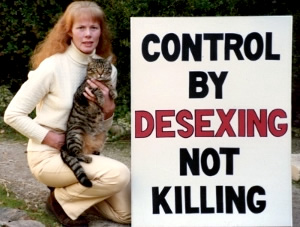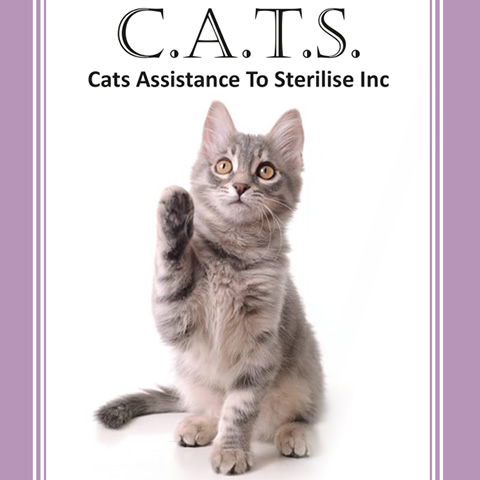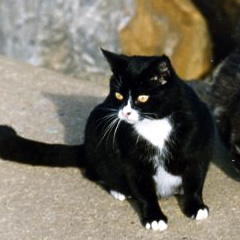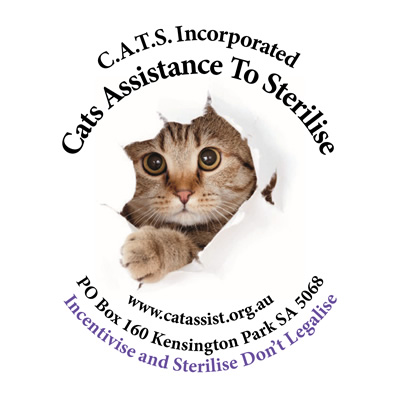
C.A.T.S. Cats Assistance to Sterilise Incorporated
PO Box 160 Kensington Park SA 5068
18/8/2024
Submission to the Dog and Cat Management (Cat Management) Amendment Bill 2024
This email Section precedes our Submission at Attachment 1, but is also part of our full response.
From – C.A.T.S. Cats Assistance To Sterilise Inc
Suburb – All areas in South Australia
Interests – Cat Management and reduction in cat numbers, cat-related problems and impact on Wildlife
Public Viewing – YES and including our name and postal address
C.A.T.S. Assistance To Sterilise Inc is submitting this response to the Public Consultation for two main reasons.
Firstly to address the proposals presented for the public consultation and
Secondly to provide a non-legislative template for successful cat management which is supported by most of the wider-community who have actually done the necessary research.
It is obvious that the introduction of the state-wide cat legislation of 2018, making microchipping mandatory, and threatening fines, fees and seizure of cats has failed. This legislation has caused a catastrophe, as most residents would not have the microchips and therefore many stopped desexing cats, both their owned cats, and even more so, unowned cats which they were feeding.
In addition, making desexing mandatory has not shown any evidence that cat desexing has increased: Indeed it has not increased. On the contrary, desexing has decreased for cats. The only reason desexing has increased for kittens is because there have been tens of thousands more kittens born due to the massive drop in the desexing of their mothers. As stated, this drop in desexing was due to making microchipping mandatory.
”Overbreeding is the root of the problem”
C.A.T.S. Recommendations to address these main reasons for overbreeding can be solved by changing the mandatory microchipping of cats to a matter of choice and ceasing the threats of fines, fees and limitation of numbers of owned cats.
1. This would immediately result in the resumption of mass desexing, particularly the mass desexing of unowned cats that people are feeding. It is obvious that Dogs and Cats Online (DACO) has failed by the low percentage of the estimated 400,000 owned SA cats recoded, and without microchips ownership of cats cannot be proved.
Letters of support for C.A.T.S. mass desexing
“The Advertiser” 29/7/2024
Vets doing good work
Regarding “Deadly bite to rising vet bills”, (“The Advertiser”, 26/7), thank goodness for Cats Assistance To Sterilise (CATS) and the wonderful vets who donate their time to CATS to help us with getting our cats desexed. Where would we be without them?
John Markham, Henley Beach South
————————————————
“The Advertiser” 31/7/2024
Keeping cats in check
I agree, a big thank you to CATS (Cats Assistance To Sterilise) and the “Vets doing good work” (Letters, 29/7) to help get the cats desexed at affordable rates, by donating their time.
Over-breeding is the root of the problem and if we desex the cats in large enough numbers we can surmount the over-breeding and reduce the feline population, which reduces the problems and impact of wildlife.
None of the other so-called controls do any good at all.
In fact the laws have made everything far worse – just look at the mass increase in cat numbers since the cat legislation! CATS have got it right.
——————————————————————-
2. Can be almost immediately solved by banning cat breeders and preventing the sale of cats.
“The Advertiser” 30/7/2023
Breeding must stop
I agree with “Collar farms” (Letters, SM, 23/7). It is ludicrous to be deliberately breeding more dogs and cats when the shelters can’t cope with the abandoned pets, and cruel people are dumping them.
Why has this not been banned in the so-called review of the Act covering dogs and cats?
At least with felines there is help available as stated, as the Cats Assistance To Sterilise people are also helping residents in my council of Onkaparinga.
Our council/RSPCA ceased desexing them, due to overflowing cat numbers
What upsets me is that while CATS are donating their time and money to preventing thousands of kitten births, the government is selling permits to almost anybody to breed thousands more.
What can we do to stop them?
Albert Peters, Woodcroft
—————————————-
“The Advertiser” 30/8/2023
Curbing kittens
What can we do to stop the government selling permits to breeders, increasing the overflowing cat population with thousands more kittens? (Letters, SM, 30/7).
The only way to reduce cat numbers is to stop the deliberate breeding of cats and promote mass desexing with cats returned to their homes to keep new undesexed cats out.
This desex and return to home method proved a significant success in the early 1990s: Records showing a massive drop in cats received and destroyed when Cats Assistance To Sterilise (CATS) pioneered its program involving tens of thousands of both owned and unowned cats.
We need people like the CATS organisation to solve the cat problems, not bureaucrats who know virtually nothing about cat management.
Kate Clayton, president Cat Protection Society of SA
————————————————————–
3. Can also be solved by repealing Council cat bylaws which, as the RSPCA has stated don’t work. RSPCA quote, “Although some councils have introduced cat bylaws, there is no tangible evidence of success”.
No cat laws work for cats.
“The Advertiser” 20/5/2023
Cat laws don’t work
Responding to “Pet fury” and “Free desexing” (Letters, The Advertiser Wednesday), I have been helping people with sterilising cats for more than 35 years and know that before the cat laws, residents were keen to desex.
Since the legislation was imposed five years ago, and also since some councils have imposed cat bylaws, many residents no longer want to desex the cats because of the threats of fines and registration fees.
In fact, every time another cat law is passed, fewer cats are desexed.
Re-homing is not sustainable, because there are not enough good homes available.
Desexing cats and returning them to their homes is sustainable, efficient and cost effective, with cats fed and cared for by residents.
The 2022 Review of the Dog and Cat Management Act 1995 simply ignores all this evidence-based information, and continues promoting its failed cat policy.
B.B. Foster, Daw Park
—————————————-
“The Sunday Mail” 3/8/2023
Desex your cats
RSPCA and AWL are correct, by refusing to take any more cats and kittens.
Why, you ask? Because until they stop, residents think that there are plenty of homes for kittens and they stop desexing cats.
Ever since the statewide legislation was imposed five years ago, forcing microchipping and registration, numbers of cats at the shelters have been doubling every year.
As the RSPCA says, overbreeding of cats is the root problem. Desexing is the only solution.
This problem will never be solved by re-homing cats through shelters and adoption agencies.
Despite the increasing number of foster carers, there are just not enough good homes to take the kittens.
Killing cats is not the answer either, as evidence shows that new undesexed cats from the estimated 200,000 unowned supply, simply restock the vacated spaces and breed more. Until the government admits that its legislative methods cannot be enforced for cats and rewrites its “Review of the Dog and Cat Management Act 1995” for cats, the catastrophe we now have will double and triple.
Cats cannot be controlled through legislative force. Cats are not dogs.
Christine Pierson, Kensington Park
———————————————
Some of these diabolical cat bylaws actually place councils at risk of litigation, as C.A.T.S. has campaigned to prove, and has succeeded in preventing councils from using them. Particularly the cat trapping cages.
Positive moves in the public consultation
This is one positive thing which the government has accepted, as these diabolical weapons of torture in the wrong hands has been acknowledged and now addressed, but it must now legislate for exemption for animal orientated organisations which have proved to be trusted to be used for humane Desex and Return to Home programs (DRH).
Letters of support for C.A.T.S. campaign
“The Advertise” 9/8/2024
Cage fight over
It has taken many years of lobbying but people power has won, so yes, “Cat cage ban welcome”, (“Letters” 7/8).
The many comments from CATS Inc and RSPCA I have read in your paper, show the cruelty and death caused by these traps when in the wrong hands.
They must only be used for transportation and return to home for vet desexing and treatment, where cats can’t be handled, and must only be with animal orientated organisations like CATS.
Ryan Davies is correct. Desexing is the only solution required for cat management, as legislation does not work for cats and never has. We only have to look at the last 30 years to see that the Dog and Cat Management Act 1995 has failed.
Richard Justice, Unley
———————————————————————-
“The Advertiser” 8/8/2024
To cage or not to cage
It’s great that the illegality of providing cat trapping cages to the public has been exposed (“Pesky cats are free to roam”, Letters, 3/8).
I have read many letters to The Advertiser from the CATS Inc organisation, calling on the government to ban these traps.
The RSPCA stopped providing the cages 10 years ago due to the terrible injuries inflicted on animals from incorrect use.
The Dog and Cat Management Act is under review with public consultation for cats now current.
We need to protest against the review document’s plan to kill cats. Killing cats has never and will never reduce numbers, as recolonisation and breeding of remaining cats will ensure numbers will be restored.
The only way to reduce numbers is to desex the cats and return them to their homes where they keep other undesexed cats out.
This significantly and humanely decreases cat numbers and problems. This method is the only reason for using these cages, where frightened cats need to be transported to the vet for desexing and treatment and returned to home, where they are loved and cared for – and it must be through animal-orientated organisations like CATS.
Luke Forrester, Burnside.
——————————————
– Re the chaining of cats to posts as stated in some cat bylaws: A positive result when Parliament voted to disallow the first attempt by the
Campbelltown Council to chain cats to fixed objects, eg posts. C.A.T.S. opposition to this appalling cruelty was supplied to Connie Bonaros MP of SA BEST which enabled her to have her Motion to disallow carried.
– By not including state-wide confinement/containment of cats in the legislation this has also been a positive move.
Preventing desexed cats from holding their territories, not necessarily on the owners/carers property restricts these cats from keeping other undesexed cats out. Desexed cats do not cause the problems of undesexed cats, such as spraying tomcat urine, caterwauling all night over mates and being more likely to leave their droppings in gardens as they can stay for days while mating, as well as females having unwanted litters of kittens. The bigger the area held by a desexed cat, the lower the ratio of cats per area is achieved.
– By not including cat registration fees, this is also a positive approach as charging registration fees would have been the last straw and reduced cat desexing to the lowest level for 30 years. Who would want to desex any cat, owned or unowned, if they were to have to pay a registration fee? Some may, but most wouldn’t, especially if it were an unowned cat: Verified by the extremely low compliance rate for recording on Dogs and Cats Online (DACO) and for registration under council cat bylaws which have registration fees.
– Not limiting cats to a specified number per household is also a positive move as the more cats that residents can get desexed and care for, from the estimated 200,000 unowned cats the better. Having residents take responsibility for these unowned cats and getting them desexed is the only way the cat population will be reduced, as killing, removing and confining them does not reduce their number, due to the Vacuum Effect.
“The Advertiser”12/8/2024
Cats in the vacuum
Regarding “Control cats, please” (The Advertiser, 9/8), documented scientific evidence proves that trapping cats and removing them from where they are not wanted achieves nothing constructive.
This is due to the phenomenon of nature known as the “vacuum effect”, which ensures another lot of new cats will move into the vacated spaces and breed to not only restore but increase original numbers.
If, however, the cats are desexed and returned to home, they will hold the territory and keep other undesexed cats away.
This results in reducing cats to the minimum required and stops further breeding while controlling the rats and mice thus deterring snakes.
Kyle Langdon, Mt Barker
Negative recommendations
Planning to encourage councils to introduce cat bylaws when the state government knows full well that enforcement of this legislation is unenforceable, is deceptive.
Cats cannot be successfully managed or controlled by legislation, already proved by the failure of Dogs and Cats Online (DACO) showing that compliance is minuscule with less than a quarter of the estimated owned SA cats being recorded. This low compliance rate is also reflected in cat bylaws where any council has introduced them.
Without a microchip, ownership cannot be proved and without proof the courts will not convict. So the few cats that are actually recorded and the few registration fees and fines that are actually paid will nowhere near cover costs, leaving the residents and ratepayers’ to foot the bill. This is not the way to win votes at the next election.
Stating that cats are considered to be owned if residents provide shelter or food to these cats, also cannot be proved as ownership: Given that cats can’t be kept out of a property without a cat-proof fence or barrier, and given that it is legal to feed birds, there is no way to prove that a cat seen on a property is owned by that resident or that the food is provided for the cat and not a bird.
It can be seen the futility of trying to hoodwink cat supporters who do have excellent brains and have had 30 years to outwit and avoid any ridiculous so-called controls specified in the Dog and Cat Management Act.
Furthermore, imposing these cat bylaws can place councils at risk of litigation as forcing cats to be collared creates risk of causing death and serious injuries: Multiple cats have suffered horrendous injuries from collars being caught across the mouth requiring expensive vet treatment including stitches, (Advertiser article with photo) eating into the flesh of the neck, caught under the forelegs and cutting into the body resulting in amputation of the leg, and also euthanasia, and death by hanging.
So it is definitely a negative move to pass the buck of cat management to the councils as they cannot enforce unenforceable cat bylaws.
The proposed plan to kill the estimated 200,000 unowned cats is simply fantasy. It has been clearly shown, multiple times, that eradication of cats in an open system will never be accomplished: This is due to the scientifically proven phenomenon of nature known as the Vacuum Effect, which ensures that new cats will move into the vacated spaces and breed to recolonise the area: Furthermore, it has been noted by scientific studies that culling results in, not only numbers being restored, but increased.
The even more ludicrous plan to kill all cats which are not deemed domesticated, including the much loved, free-living cats which tens of thousands of residents have had desexed through the C.A.T.S. scheme, is not only horrendous but has caused an enormous amount of anger and hatred towards the government which has been made very clear in about 30 or more letters published in “The Advertiser” and “The Sunday Mail” since about the time of the “Review of the Dog and Cat Management Act 1995 was written.
The following include a few of the many letters from those who discovered the contents of the Review of the Dog and Cat Management Act.
First letter in “The Advertiser” 8/1/2024
Scratch cat laws

The last five years under the Dog and Cat Management Act 1995 and Amendments have proved cats cannot be managed by legislative force with threats of fines, fees and seizure of cats.
The more laws imposed, the fewer cats are desexed, proved by C.A.T.S. Cats Assistance To Sterilise Inc records. C.A.T.S. desexes more cats for the general public than any organisation in SA – currently 135,000. (The main shelters do not desex for the general public.)
After the statewide cat legislation was imposed on July 1, 2018, cat desexing plummeted to half, as residents refused to have mandatory microchips and record on Dogs and Cats Online (DACO).
This was proved by the low percentage of the estimated 400,000 SA cats recorded. As undesexed cat numbers skyrocketed, so did massive problems at shelters, until the current catastrophe when RSPCA and AWL overflowed.
Our government has no idea how to manage cats or cat supporters, and until it learns that working with the people who care for the cats and not against them, nothing desirable will be achieved.
C.A.T.S. was incorporated on November 1, 1989, before any cat laws at all, and proved that co-operation, correct education and assistance with desexing for all moggies, and returning them to their homes to keep out new, undesexed, intruder cats, halved the numbers of felines received and destroyed at the main shelter, within five years. (Records confirm this.)
And Reark research found in 1992 that SA had the highest rate of desexed cats for any state surveyed: 94 per cent. If C.A.T.S. – on its minuscule budget and run by animal supporters who donate their time and money, with the support of wonderful cooperating vets – halved the cat numbers in five years, while the government, on its billion-dollar budget, has doubled the cat numbers in five years, then why should this failed cat legislation be supported?
And as Mayor Glenn Docherty said, (Playford) Council was not considering a cat curfew. “It is (already) an expiable offence under the Local Nuisance and Litter Control Act for cats to cause local nuisance, including wandering.”
So why do we need any more laws specifically for cats?
Christine Pierson, president, C.A.T.S. Cats Assistance To Sterilise Inc
—————————————————————————————-
“The Advertiser” 19/6/2023
Change needed
I agree with “Review catastrophe” (The Advertiser, 14/6). We need to go back to the drawing board, but not the Dog and Cat Management Board, to rectify the catastrophe caused by the 2018 act.
During public consultation, prior to 1995, the numerous submissions sent to the government stating legislation for cats would fail, were ignored.
Managing cats cannot be compared with managing dogs.
We don’t have an estimated 200,000 wild dogs living in populated areas as with cats.
The proposed Review of the Dog and Cat Management Act 1995 solution is to confine the domesticated cats and kill all the others.
Removal, confinement and killing of the “others” would result in recolonisation by new undesexed cats and increases in numbers, not decreases.
Before cat laws, SA had the highest percentage of desexed cats in Australia (REARK research survey) and mass desexing of cats, owned and unowned, through the low-priced CATS scheme had reduced cats received and destroyed to half at the main shelter.
As more cat laws were passed, fewer cats were desexed, and numbers gradually rose until the catastrophe since 2018, when RSPCA stated they were “the highest we have held in our memory” (Channel 9 News, 10/6/2019) and then were “double to 5 years ago” and the CEO told The Advertiser that the RSPCA could take no more (11/3 ).
SA needs to follow the Queensland government which has repealed its cat management legislation, citing it as “ineffective and costly for local government”.
James M. Richardson, Waterloo Corner
———————————————————–
“The Advertiser” 18/6/2023
Don’t cage cats
I refer to veterinarian Mark Reeve’s pet advice column “Could our cherished animal friends be making us sick?” (Sunday Mail, June 11).
This is the case if cats are permanently confined in houses and small cat-runs.
Already cats are becoming unhealthy from lack of exercise and unable to fulfil their basic needs of running, jumping, eating grass in the garden.
Cats not able to satisfy their insatiable curiosity are becoming stressed and anxious and hospital reports show a significant increase in attacks on owners from confined cats.
When cats become obese, lack fresh air, sunshine and freedom, they become sick. Isn’t it obvious that keeping cats permanently inside with smelly litter trays, fleas that accumulate when cats are confined, and parasites, is not in the best interests of human beings either?
This is simple common sense. We have already seen the spread of avian flu and shocking pandemics from animals which are confined in factory farms.
We should be getting animals out of cages, not passing laws to imprison them. The Review of the Dog and Cat Management Act 1995 needs to be reviewed.
Christine Pierson, Kensington Park
————————————————-
“The Advertiser” 14/6/2023
Review catastrophe
Where is the review in the Review of the Dog and Cat Management Act 1995 regarding cats?
Nothing has been reviewed regarding the massive failure of this Act, and the plummeting of cat desexing, as residents will not comply, have microchips and record on Dog And Cat Online (DACO) and, for fear of fines, fees and seizure of their cats, they don’t desex them either.
Nothing has been reviewed to stop the catastrophic skyrocketing of undesexed cats due to this huge drop in desexing, with the RSPCA refusing to accept anymore.
All that the section on cats includes is ridiculous plans that will exacerbate the problem caused by the legislation imposed five years ago.
Hasn’t Susan Close got anybody on her Dog and Cat Management Board who knows anything about cats?
Carol Patricia James Kensington Park
———————————————————
“The Advertiser”
Know cat instincts
Cats are not dogs and until the government understands cat behaviour it will never successfully manage cats.
So its aim in “Claws are out for roaming pet cats” is pointless (The Advertiser, 5/1). The letter “Scratch cat laws” (The Advertiser, 8/1) from CATS (Cats Assistance To Sterilise Inc) speaks volumes, all evidence-based on their own 35-year studies, with both hands-on personal involvement with cats and the cat supporters in areas where the cats live, in both rural and urban locations.
Most importantly, cats don’t “roam”, which means “to move about or travel aimlessly or unsystematically”.
Cats travel with a purpose and until this purpose is understood as a basis for a cat management plan, nothing constructive will be achieved.
Cats travel to find mates, solved by desexing; cats travel to find food, solved by correct feeding; and cats travel to find a place to do their business, solved by feeders providing cat toilets at home with clean leaves and freshly dug earth, or a covered, outside litter tray.
Recognising these three reasons why cats leave their homes and addressing them, provides the solution to almost all of the complaints reported to councils.
One of the many examples illustrating this success is my own Council of Norwood Payneham & St Peters, where the partnership between council and CATS has resulted in free desexing for all moggie residents.
While government pushes its counterproductive legislative approach and increases its unenforceable threats of fines and fees, plus plans to kill the cats, it drives the cat supporters underground, and mass desexing of cats, which was so successful before the cat laws, will plummet even further with an even further increase in undesexed cats.
The idea that all cats be confined to home areas and all cats not deemed domesticated killed, ignores the phenomenon of nature, the Vacuum Effect, as the estimated 200,000 unowned cats will restock the vacated spaces.
But even worse, this cruelty has so infuriated the cat-supporting community that no likelihood of any acceptance by the public will be forthcoming to support the government’s plans.
Without the support of the people who care for the cats there will be no progress in reducing cat numbers, problems or impact on wildlife.
Jason P. Sanderson, Norwood
————————————————-
This outpouring of opposition has made it quite clear that the government will never get any help from the genuine cat supporters who have simply gone underground.
Many of these supporters will never send you submissions or respond to surveys as they will not provide their names and addresses, similar to the way they will not record their details on Dogs and Cats Online (DACO).
These one-sided surveys and responses mainly reflect the anti-cat minority who have nothing to lose by including their names and addresses and no doubt there will be many, as the whole public consultation presentation was blatantly aimed at getting such responses by featuring cats as savage, wildlife killers. The cat with its mouth open was a terrified cat caught in cage with the bars photoshopped out. This was a coercive and despicable attempt to sway the public opinion against cats, and not honest. In addition the cat with the bird in its mouth represents possibly 15% of its prey, while a cat with an introduced species; rat, mouse or rabbit, would make up at least 85% of the cat’s prey; proved by scientific studies: Another despicable misrepresentation. So this presentation has also caused an huge amount of anger and resentment towards not only your legislation, but your government.
Before the cat legislation of 1995
It needs to be seriously noted that before any cat legislation in SA, C.A.T.S. through mass desexing of all cats, owned and unowned, reduced the numbers of cats being destroyed at the Animal Welfare League, the main shelter for cats at that time (as it was accepting 3 to 4 times as many cats as the RSPCA), to virtually half, within 5 years: This graph below, shows the results that can be achieved by working with the residents through co-operation, education and assistance with desexing.
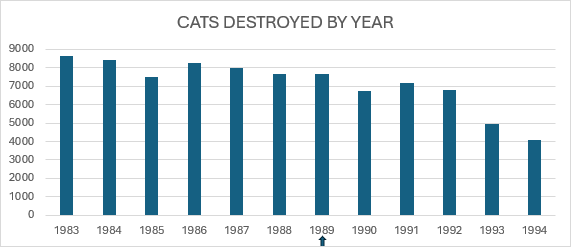
C.A.T.S. Inc was incorporated in late 1989. Note the significant drop in cats being destroyed after C.A.T.S. began its mass desexing of all cats, owned and unowned in the 5 years after C.A.T.S. was incorporated on 1 November 1989.
The 1992, REARK Research conducted a survey which found that SA had the highest rate of desexed cats for any state surveyed in the country.
This was also due to the mass desexing of all cats, owned and unowned, conducted by C.A.T.S. through wonderful cooperating vets. No cat bylaws were operating at this time.
Using our template, Norwood Payneham and St Peters Council has been so successful in controlling its cats through the partnership with C.A.T.S. that it has now had free cat desexing for all resident moggies, owned and unowned for over 2 years. (please see the second link below) and Council stating that “No expiation notices have been issued for cat related offences”.
A simple guide to all that is required in C.A.T.S. state-wide Booklet can also be found in this easy to read publication which is suitable for any age, at the first link below.
catassist.org.au/wp-content/uploads/CATS_A5Booklet_20pg.pdf
FREE Cat Desexing for Norwood Payneham & St Peters Council – C.A.T.S. (catassist.org.au) (Click on the wording – Read our full PDF Booklet )
The Submission, Attachment 1, therefore addresses all that is required to solve the main overbreeding of cats in South Australia, as the methods used have been tried and tested for over 35 years and, in those areas where this program has been applied en masse, have the proven results: Cat numbers have reduced, as have the cat-related problems and complaints, and also the impact on wildlife: This reduction, although successful, however, has been severely reduced by the legislation of 2018. (please see Attachment 2: Vice President’s letter)
We respectfully ask that you read our Submission and seriously reconsider your current legislative approach to Cat Management which has failed to successfully accomplish any of its aims or achieve any of its goals, regarding reducing cat numbers, cat-related problems and impact on native wildlife.
C.A.T.S. template however, has proved that all its aims have been successful and all its goals have been achieved. Our method of Desex and Return to Home of all cats, wherever possible, which rely on food provided directly or indirectly from human sources has been well received by the community. These cats include, friendly, non-friendly, farm, cats in factories and industrial sites, and cats which simply turn up in the gardens begging for food. Over 135,000 cat desexings have been organised through the C.A.T.S. low-priced desexing scheme.
Our goals of reducing cat numbers, cat-related problems and impact on wildlife had also been achieved and were working well before the cat legislation was introduced as the Dog and Cat Management Act 1995. This can be verified by reading the graph on page one of the attachment.
This is the template that needs to be adopted by State government and expanded on a large scale. C.A.T.S. will assist to help in any way we can to achieve this, now our ultimate goal, of making non-legislative cat management a state-wide success.
Our full Submission follows at Attachment 1 which provides a fully proven and successful template for managing cats WITHOUT legislation.
